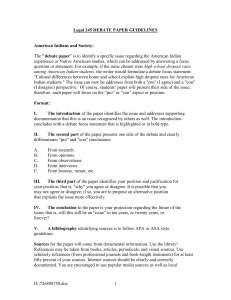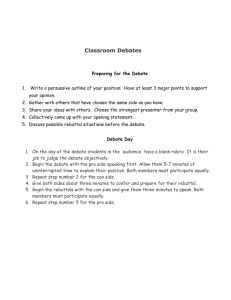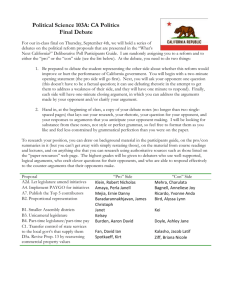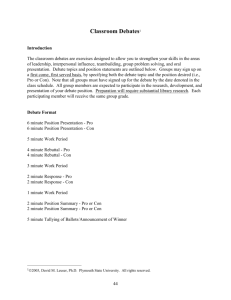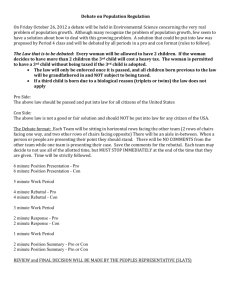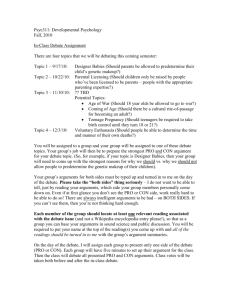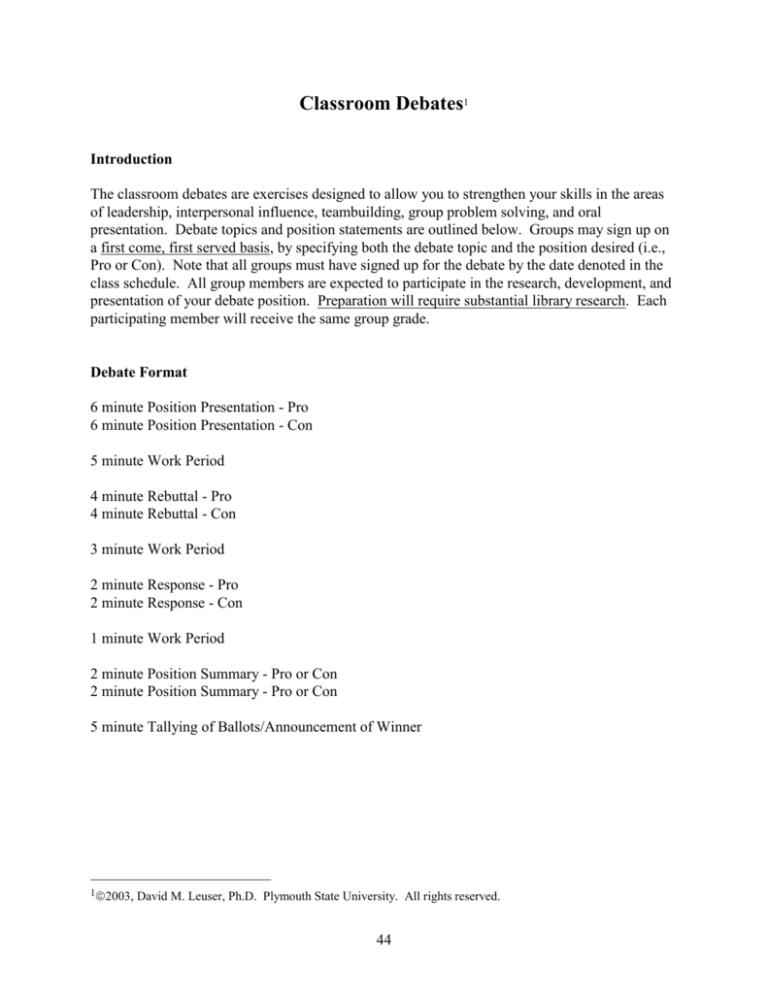
Classroom Debates1
Introduction
The classroom debates are exercises designed to allow you to strengthen your skills in the areas
of leadership, interpersonal influence, teambuilding, group problem solving, and oral
presentation. Debate topics and position statements are outlined below. Groups may sign up on
a first come, first served basis, by specifying both the debate topic and the position desired (i.e.,
Pro or Con). Note that all groups must have signed up for the debate by the date denoted in the
class schedule. All group members are expected to participate in the research, development, and
presentation of your debate position. Preparation will require substantial library research. Each
participating member will receive the same group grade.
Debate Format
6 minute Position Presentation - Pro
6 minute Position Presentation - Con
5 minute Work Period
4 minute Rebuttal - Pro
4 minute Rebuttal - Con
3 minute Work Period
2 minute Response - Pro
2 minute Response - Con
1 minute Work Period
2 minute Position Summary - Pro or Con
2 minute Position Summary - Pro or Con
5 minute Tallying of Ballots/Announcement of Winner
12003,
David M. Leuser, Ph.D. Plymouth State University. All rights reserved.
44
Debate Procedure
The debate will take the form of timed individual and/or group presentations and responses
separated by timed group work periods. The rules applied may deviate from the formal rules of
debating. When questions arise, the judgment of the instructor will provide the definitive ruling.
Prior to the beginning of the class period, both teams are to position their desks facing each other
at the front of the room. Each team is to write its team name, debate position, and debate
position statement on the blackboard behind their desks. Note that absolutely no changes may be
made to the position statements presented below. You must argue them exactly as written!
Team members may speak either from their desks or from the podium, as they desire.
Audiovisuals may be used at any time, including, but not limited to, handouts, flipcharts,
transparencies, slides, audio and videotapes, etc. While a team is not required to use all of the
time allocated to each debate component, speakers must stop immediately when the allocated
time runs out. Team members are prohibited from speaking to the audience or opposing team
except at the times specifically allocated to them. Thus, there can be no immediate, reciprocal
interchange of comments between the teams. The sequence of the position summaries will be
determined by a random procedure at the conclusion of the final work period. Note that no new
information may be introduced during the summary. Doing so may result in disqualification of
the offending group. If either team feels that their opponents are introducing new information
during the summary, they may challenge them immediately and request a ruling from the
instructor.
Selection of Winner(s) and Allocation of Points
The instructor reserves the right to allocate fewer than the default or class voted points to a
group, if, in his opinion, the quality of preparation and/or presentation was inadequate. Debate
"losers" who prepare and present adequately will receive 30 points for their efforts.
Debate "Winners" will be selected in two ways, as follows:
Audience Vote: Class members in the audience will vote by secret ballot for a debate winner.
Votes are to be based upon presentation quality only, and not upon personal agreement or
disagreement with the position espoused. At the conclusion of each component of the debate,
class members will be asked to assign a point rating along with explanatory comments to each
team for their performance during that component. When the debate is over, the point ratings
will be summed. Whichever team has the higher sum will be the winner on that ballot. After all
ballots are collected, the number of votes for each team will be announced. Whichever team has
more votes will be the winner, and the team will receive 10 bonus points in addition to the 30 for
basic preparation. In the event of a tie, the instructor’s vote will decide the winner.
Instructors' Vote: The instructor will also evaluate both teams according to the above procedures
and criteria, and select his choice for the winner. The team of his choice will receive 10 bonus
45
points. Thus, depending upon the nature of the vote split, the "Winner(s)" may receive 10 or 20
bonus points, for a total of either 40 or 50 points for the debate.
Review of Ballots
Each debating team will have the opportunity to take home all of the ballots overnight for review
and feedback on their performance. If necessary, the team to take them first will be determined
by the flip of a coin. Once both teams have reviewed them, they are to be returned to the
instructor.
Debate Topics
What was the impact of the Tariff of Abominations and Nullification Crisis on the United States?
PRO: The tariff was a necessary evil to make us a stonger and more independent nation. We
were able to mediate the impact of the Tariff of Abomination which should minimize the impact
on our southern agricultural communities.
CON: The Tariff of Abominations created a crisis for our nation and brought into question the
unity of the United States. We question the desire of the United States government if it is willing
to isolate and punish an entire region for the benefit of another.
National Bank
PRO: The National Bank has been seen as Constitutional by the Supreme Court and adds
stability to our nations economy.
CON: The National Bank favors only the rich and all of the economic support it provides can be
done through the sanctioned state banks. States should control the economy since it is not
specifically decided on in the Constituion as a federal requirement.
Indian Removal
PRO: The uncivilized Native Americans are standing in the way of progress. Southern planters
can use the land more effectively and the Natives should be removed to land in the west.
CON: The Native Americans have lived on this land since before we came. They are using the
territory and have been promised it by the federal government. Removal of the Natives to
croweded reservations in the west is wrong.
46
DEBATE BALLOT
Debate ______________________________________________ Class _____________
Name of Evaluator ____________________________________ Date _____________
1
Poor
2
Fair
3
4
Average
5
Good
PRO
Excellent
CON
6 Minute Position Presentation
Rating = ____
Comments:
Rating = ____
Comments:
***** 5 Minute Work Period *****
4 Minute Rebuttal
Rating = ____
Comments:
Rating = ____
Continued on Reverse ---------->
47
Comments:
***** 3 Minute Work Period *****
2 Minute Response
Rating = ____
Comments:
Rating = ____
Comments:
***** 1 Minute Work Period *****
2 Minute Position Summary
Rating = ____
[
Comments:
Rating = ____
] Total Points (20)
[
Comments:
] Total Points (20)
Circle Winner Below:
PRO
CON
General Comments:
Signature of Evaluator:
______________________
48
Team Presentation Evaluation2
Team Name ____________________________________________
Grade _______
Topic _________________________________ Date___________ Duration _______
Content
1 2 3 4 5
Overview (Review/posting of agenda; Summary of case)
1 2 3 4 5
Diagnosis/Analysis (Review of chapter content; Issues/Problems in case)
1 2 3 4 5
Quality of Recommendations/Explanations (Reccs for what should be/
have been done differently, OR, Expls for why current situation successful)
1 2 3 4 5
Summary/Conclusion (Review of major points; Statement of relevance to
practice of management)
Process
1 2 3 4 5
Verbal Behavior (clarity/choice of words/voice level)
1 2 3 4 5
Nonverbal Behavior (posture; gestures/movement; eye contact; presence;
use of notes/reading)
1 2 3 4 5
Variety in Style (lecture; discussion; game; activity; skit; role play; quiz)
1 2 3 4 5
Timing (Within limit; coordination; use of time)
1 2 3 4 5
General Coherence (Ability to follow points; quality of transitions)
1 2 3 4 5
Creativity/Psychological Impact
_________Content / 20 points possible
2
____________/Process 30 points possible
1999, David M. Leuser, Ph.D. Plymouth State College of the University System of New Hampshire.
49
Strengths
Weaknesses
Improvements
General Comments
Signature of Evaluator:
__________________________________
Mrs. Milito
50
51

